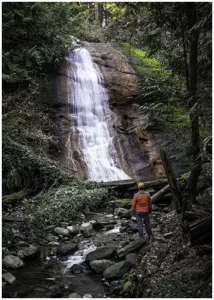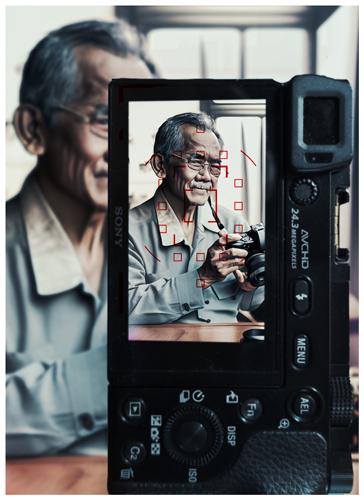
The Charming Northfield Falls in the Heart of Beach Estate Park
Looking to kill off an hour while in Nanaimo, BC? Just a short hop-skip and


Are your images blurry, or out-of-focus, tired of missing those perfect shots? Whether you’re a beginner or a seasoned pro, understanding focus points in photography will help you to capture tack-sharp, photos. In this article, we’ll demystify focus points, empowering you to unleash the full potential of your camera. We’ll let you in on our secret every photographer should know: Let’s get started!
Focusing in photography isn’t just about clarity, but it plays a crucial role in directing your viewer’s attention and dictating the mood of a shot. In its simplest definition, “focus” refers to a specific portion of an image that’s sharper than the others.
Consider focusing to being a maestro conducting the orchestra. When photographers say “focal point,” they usually mean that part of the shot they want to steal the show. It could be a single point or several, and guess what? You decide on where to focus.
Think of it this way. What’s the first thing you’re drawn to when looking at a photograph of a person? Bingo, it’s the eyes. Naturally, as photographers, you’d want the eyes to be the sharpest point, the focal point in your photo.
However, focusing doesn’t come with a one-size-fits-all. This is where your handy little friends, focus points, come into play. Picture them as invisible dots scattered across your frame, ready to jump into action whenever you decide. An active focus point could be at the centre or at the corner of your frame, focusing on that part of the scene that lies “under” it.
So, next time you’re behind the lens, take a moment before hitting the shutter button. Ask yourself, “What’s my focal point?”
Understanding where to focus when taking a photograph can dramatically enhance your images, strengthening communication with your viewer. But how exactly do you determine your focus point to get that winning shot? Let’s unravel this together.
Selecting and enhancing your focus point involves being alert to composition, light, and colour contrast—basically, the visual weight within your frame. It may seem a bit challenging at first, but hold on; trust me, it gets better with some practice. Here’s a breakdown of points to consider:
Remember, there’s no one-size-fits-all answer to where you should focus in your photograph. It’s a creative, artistic decision primarily based on the image you want to capture and the story you want to tell. After all, photography is all about experimenting and experiencing.
Focus points are an incredibly powerful feature of your camera. They allow you to precisely control where the camera will focus, ensuring that the subject you’re photographing is sharp and clear. With a wide array of focus points to choose from, you have the flexibility to frame your shots exactly as you envision. Taking full advantage of focus points will greatly enhance the quality of your photographs. They help you nail that perfect shot by allowing you to pinpoint and track your subject with precision.
Whether you’re capturing a fast-moving athlete or a beautiful wildlife moment, focus points ensure your subject stays sharp and in focus. So, don’t underestimate the power of focus points.
Let’s dive into the autofocus systems and introduce you to the two heavyweight contenders – Phase Detection and Contrast Detection. We need to understand them to master the art of perfect focus.
Phase detection autofocus is superfast and tracks moving subjects like a pro. It doesn’t call in a heavy load of computational work from your camera, which is a relief. But keep in mind, it’s prone to errors and internal misalignment. No worries though, as some cameras let you calibrate your phase detection system to minimize these potholes.
On the other hand, contrast detection autofocus plays the patience card. It requires your camera to process more data, resulting in a bit more time to lock focus. Although it isn’t a fan of speed and moving subjects, it scores high in precision, directly measuring the data from your camera sensor. If your subject ain’t running like The Flash, like in landscape photography, contrast detection is your go-to buddy.
Phase Detection:
Here’s the list converted into a table format:
| Pros | Cons |
|---|---|
| Fast and ideal for tracking moving subjects | More prone to errors and internal misalignment. |
| Less computational work for the camera. | Provides a limited number of autofocus points. |
| Calibration options to minimize errors. | Ineffective in low contrast scenes. |
| Sensors specifically designed for precise focusing. | Not as precise as contrast detection. |
| Most DSLRs today adopt this system. | Could be complicated for beginners. |
Contrast Detection:
| Pro's | Con's |
|---|---|
| Gives you complete control over your photo's focus. | Can be time-consuming, especially when precision is required. |
| There are no limitations on the camera or lens you're using. | Requires a steady hand and a good eye. |
| There are no limitations on the camera or lens you're using. | Might not be convenient when rapid shots are needed. |
| Helps with precision focusing in challenging conditions or tricky subjects. | In low light conditions, manually focusing can be quite challenging. |
| You can lock the focus for a series of shots. | It often requires the use of certain features like focus peaking or magnification which might not be available on all cameras. |
Tip: Use these autofocus systems wisely based on your requirements. For instance, if you’re shooting a sports event or a hectic wedding scene, the speed of phase detection may be beneficial. But when you’re into portrait or landscape photography where precision is vital, contrast detection comes in handy. Happy shooting!
Let the debate begin, autofocus vs manual focus, these two have always been jostling side by side, each having their own charm. There is a time and a place for both.
Let’s kick things off with the killer features of both:
And now, let’s dig into the pros and cons, shall we?
Manual Focus:
Unlock creative freedom and precision with manual focus, allowing you to take full control over your subject’s sharpness, depth of field, and artistic vision.
| Pro's | Con's |
|---|---|
| High precision with static and slow-moving scenes. | Not as fast as phase detection. |
| Makes use of the main sensor for focusing. | Struggles with tracking moving subjects. |
| Supports an almost unlimited number of autofocus points. | Slower focus due to increased computational work. |
| Excellent for high contrast and well-lit scenes. | Less effective in low light or low contrast scenarios. |
| Generally used in an array of cameras, from mirrorless to compacts. | May struggle with subjects that have similar textures. |
Autofocus:
Never miss a moment with the game-changing benefits of autofocus, effortlessly capturing sharp and focused shots every time, allowing you to fully immerse yourself in the art of photography.
| Pro's | Con's |
|---|---|
| Quick and convenient, saving time for you. | Not all cameras and lenses come with an autofocus motor. |
| Highly effective in tracking moving subjects, thanks to systems like AF-C (Continuous Autofocus). | In certain lighting conditions, autofocus may struggle or fail. |
| Often more accurate, making it a favourite for sports and wildlife photographers. | The system might choose to focus on the wrong subject in complex scenes. |
| There are different autofocus modes (AF-S, AF-C) to suit different situations. | Constantly using autofocus may limit your learning of photography fundamentals. |
| The system is even capable of choosing the subject to focus on. | Certain cameras might not have all autofocus modes. |
A focal point in photography is a critical piece that highlights the most important part of your photo. Imagine a scenic image of a park; the focal point might be a vividly painted bench, becoming the showstopper amongst the surrounding greenery.
Creating focus points is an art in itself. To master it, here are some expert tips:
Focus points in photography are the game-changers giving you an edge when capturing lively, active scenes. They’re like your camera’s magic eye, choosing where to sharpen the visuals and make your shot stand out.
Just remember, more autofocus (AF) points mean sharper, better-focused shots.
Understanding focus points in photography is key to capturing great images, even in challenging lighting conditions.
To make use of focus points in challenging light conditions:
Applying these techniques will lead to better-focused images, even in complex light conditions.
Focus points are the secret sauce for capturing breathtaking action shots. They allow you to effortlessly track and maintain focus on moving subjects, freezing the perfect moment in time. Here’s how focus points make it happen:
Imagine photographing a skateboarder performing tricks. Choose the skater’s face as the focus point using continuous autofocus. This will ensure that your camera captures their movement with sharpness and dynamism.
Get ready to level up your portrait and close-up game with the power of focus points! When shooting portraits, using focus points allows you to highlight the subject’s eyes or face, adding depth and personality to your shots. Here’s how to make it happen:
Remember, focus points are your secret weapon for achieving professional-quality portraits and close-ups that truly shine.
I very seldom settle for the default focus points. Often when getting the camera set up I’m working on changing where I want my focus point to be, and how many focus points I’m going to use.
Remember, the beauty of photography lies in exploring and pushing boundaries. So go on, embrace the joy of experimentation with focus point.
Photography is all about capturing the world from your unique perspective. One way to infuse uniqueness is experimenting with different focal points. You can isolate your subject for a clean, uncluttered focal point, or play with contrasting colours to achieve vivid results.
An all-too-common slip-up in photography is forgetting to set the focus point. Often, it results in viewers drawn to unintended elements in the image. To avoid this, follow these tips:
When setting up your shot, remember to check your focal point. . All to often we get in a hurry to click the shutter button, and forget about where the focus is set. Done it many times.
Let’s talk about a common hiccup in photography – not properly using the autofocus mode. Sure, you’ve probably faced it at some point, right? You’re out there, camera in hand, lined up the perfect shot, but then comes the struggle – the frustrating dance between you and your camera as it fails to focus where you want.
Some neat tricks to grab sharper photos:
And here’s a bonus tip – dig around for your camera’s manual or find a PDF online. It contains a wealth of information on how to tweak and handle those focusing issues.
Focusing on moving subjects is a common hurdle many of us face. We’ve been there: you’ve got the perfect fast moving subject, maybe a bird in flight or a bustling crowd, and you attempt to lock focus, only for it to get into a blurry mess. Discouraging, but remember, it happens to the best of us.
So why does this mistake occur? Moving subjects are, well, moving. This constant change confuses our autofocus systems, reducing its accuracy significantly.
But of course, no autofocus system is foolproof. Things can get tricky, especially when lighting is poor. Cameras, just like our own eyes, struggle to focus in low light conditions. In such cases, the good old manual focus mode coupled with live view can be a true savior. Try lighting your subject with a torch or headlight to assist in focusing.
A very creative way to focus on a moving subject is to capture motion blur, intentionally blurring the subject in motion. For this, you’ll need a slower shutter speed, like 1/30 seconds or even less. This creates a fascinating contrast between the still and moving elements of your scene.
Reality is, focusing can be tough in some situations, and not just with autofocus. Manual focus can also be quite the challenge under specific conditions. So when in doubt, try the above techniques, and you’ll be capturing sharp, dynamic shots in no time.
Photography is an art form marked by mastery of various techniques, one is focus. If you’re recently finding your photos are blurry and less sharp than you’d like, then it’s high time for a little focus on focus!
One common mistake is not taking the time to practice. Here’s why practising with focus is essential and a few tips to avoid this mistake:
Wowzer, let me first apologize for such a long post. When I started to write this post I never thought is would this long. However, understanding and controlling your focus points can absolutely take your photography skills to the next level. You’ll find that with a little practice, your eyes will naturally identify the strong focal points. This improved instinct, in turn, makes your images more compelling and better at communicating your intended message. So, don’t shy away from experimenting and remember, every great photographer was once a beginner, trying to figure out focal points just like you. In the end, it’s this journey of learning and experimenting that enables you to capture those astounding shots that leave your viewers spellbound!
A camera focuses by utilizing autofocus mechanisms that detect contrast, movement, or distance to achieve sharpness. These mechanisms analyze the input from focus points, allowing the camera to adjust the lens position and create a clear, focused image.
The focal point is crucial in photography as it determines the area of sharpness and draws attention to the subject. It allows photographers to create depth, emphasize details, and guide viewers’ eyes to the intended point of interest in the image.
The types of focus in photography typically include manual focus, single autofocus (AF-S), and continuous autofocus (AF-C). Manual focus allows precise control, while AF-S locks focus on a specific point, and AF-C tracks moving subjects.

Looking to kill off an hour while in Nanaimo, BC? Just a short hop-skip and

Photography can be a fulfilling and enjoyable hobby that brings a creative outlet to your

Welcome to our guide to Photoshop tutorials for beginners: A Complete Beginner’s Tutorial for Learning